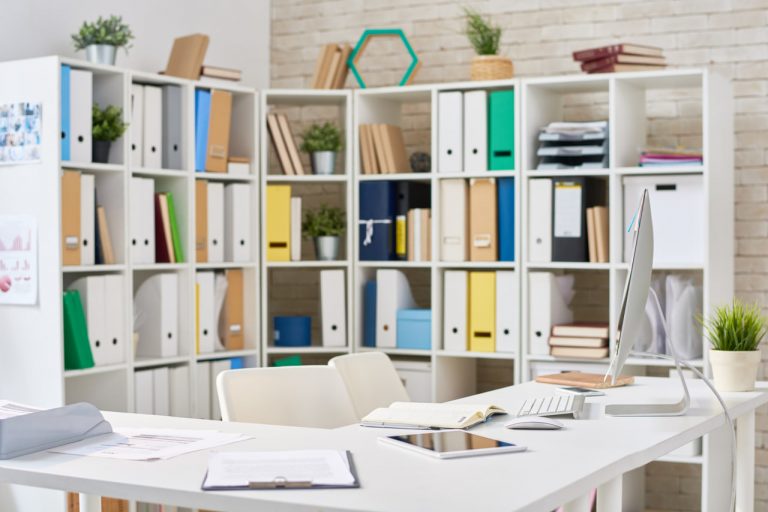Creating an efficient home office is more important than ever. Whether you’re working remotely, freelancing, or running your own business, having a functional and organized workspace at home can make a world of difference in your productivity and mental well-being. When your home office is well-designed, it can help you stay focused, reduce distractions, and allow you to work comfortably and effectively.
In this blog, we’ll explore practical tips and strategies to help you create a home office that enhances your workflow, supports your productivity, and promotes your overall well-being.
1. Choose the Right Location for Your Office
The first step in creating an efficient home office is selecting the right location. The space you choose will have a big impact on your ability to concentrate, stay organized, and separate work from personal life.
Here’s how to choose the right location:
- Find a Quiet Space: Ideally, you want a space that’s free from distractions. Avoid setting up your office in high-traffic areas like the living room or kitchen, where noise and interruptions are common. If you don’t have a dedicated room, find a corner or nook in your home that can be used exclusively for work.
- Ensure Good Lighting: Lighting is crucial for productivity. A well-lit space can help reduce eye strain and create a positive work environment. Ideally, your office should have access to natural light, as daylight improves mood and energy. If that’s not possible, invest in good-quality task lighting (such as a desk lamp) and ambient lighting to create a comfortable work atmosphere.
- Create Boundaries: In a home office, it’s easy to let personal life bleed into your work. If possible, create physical boundaries in your space, such as using a room divider or positioning your desk in a way that separates work from the rest of your living area. This will help you mentally “clock in” and “clock out” and maintain work-life balance.
2. Invest in Comfortable, Ergonomic Furniture
When you work from home, you need furniture that supports your posture and well-being. Spending hours sitting at a desk without proper support can lead to back pain, neck strain, and other health issues. Investing in ergonomic furniture is key to ensuring both comfort and efficiency.
Here’s what to consider when selecting office furniture:
- An Ergonomic Chair: Your chair is one of the most important pieces of furniture in your home office. Look for a chair with good lumbar support, adjustable height, and armrests. A well-designed ergonomic chair will help you maintain a proper posture and reduce strain on your back and neck during long work sessions.
- A Spacious Desk: Choose a desk that fits your workflow. It should have enough space for your computer, paperwork, and any other items you regularly use. A desk with built-in storage can help you keep your workspace organized and reduce clutter.
- A Comfortable Keyboard and Mouse: Ergonomically designed keyboards and mice are a must if you spend a lot of time typing. An adjustable keyboard tray can help you maintain a natural wrist position while typing, reducing the risk of repetitive stress injuries like carpal tunnel syndrome.
3. Organize Your Workspace for Maximum Efficiency
A cluttered desk leads to a cluttered mind. Keeping your workspace organized is essential for maintaining focus, reducing distractions, and improving efficiency. Here’s how to organize your home office:
- Use Storage Solutions: Invest in filing cabinets, shelving units, or drawer organizers to keep papers, office supplies, and other materials neatly stored. Make sure everything has a place so you can easily find what you need without wasting time searching for it.
- Declutter Regularly: At the end of each workday, take five minutes to tidy up your desk. Clear away unnecessary items, file away documents, and wipe down surfaces. A clean and organized workspace will help you start each day with a clear mind.
- Cable Management: If your office is home to various devices and cables, consider using cable organizers or clips to keep everything neat and out of sight. This will prevent cables from tangling and reduce visual clutter, making your space look cleaner and more professional.
- Create Zones: If you have a larger workspace, try dividing it into different zones for various tasks. For example, one area could be dedicated to paperwork, another to your computer and technical equipment, and a separate area for brainstorming or reading. By creating zones, you can increase your focus and keep tasks more organized.
4. Optimize Your Technology and Tools
Technology is the backbone of most modern work environments. The right tools and technology can make your work more efficient, while outdated or unreliable equipment can lead to frustration and wasted time.
Here’s how to optimize your technology for your home office:
- Invest in Reliable Equipment: Ensure your computer, monitor, and other essential devices are in good working order. A slow or malfunctioning computer can waste precious time and hinder productivity. Consider upgrading to faster hardware or investing in a larger screen to help you multitask more efficiently.
- Upgrade Your Internet Connection: A strong and stable internet connection is crucial, especially if your job involves video calls, remote collaborations, or large file transfers. If your connection is unreliable, consider upgrading your plan or investing in a Wi-Fi extender to ensure a smooth and uninterrupted work experience.
- Use Productivity Tools: Software tools like task managers (e.g., Todoist, Trello), communication apps (e.g., Slack, Zoom), and cloud storage (e.g., Google Drive, Dropbox) can help you stay organized, collaborate with colleagues, and track your progress. Take time to set up systems that will support your workflow and make your day-to-day tasks more efficient.
- Keep Backup Solutions: Backup your files regularly using cloud storage or external hard drives. Having a backup plan in place will help you avoid data loss due to technical issues and keep your work secure.
5. Personalize Your Space for Inspiration
Your home office should not only be functional—it should also be a place where you feel inspired and motivated to work. Personalizing your workspace with items that make you happy can boost your mood and creativity.
Here are some ideas to make your office feel more inviting and inspiring:
- Add Plants: Bringing a bit of nature into your workspace can improve your mental clarity and reduce stress. Low-maintenance plants like succulents, snake plants, or peace lilies are perfect for small home offices and can be placed on shelves, desks, or windowsills.
- Incorporate Artwork or Photos: Surround yourself with art that you love or motivational quotes that keep you focused. Personal touches like family photos or inspirational posters can make your office feel more like “you,” creating a positive and encouraging environment.
- Use Color Wisely: Colors can have a profound impact on your mood and productivity. For example, blues and greens are calming and can improve focus, while yellows and oranges are energizing and can spark creativity. Choose colors for your walls, furniture, and decor that reflect the atmosphere you want to create.
- Add Comfortable Touches: Consider incorporating comfortable accessories like a soft rug, a cozy throw blanket, or decorative cushions on your chair. A little comfort goes a long way in making your office feel like a space you enjoy spending time in.




